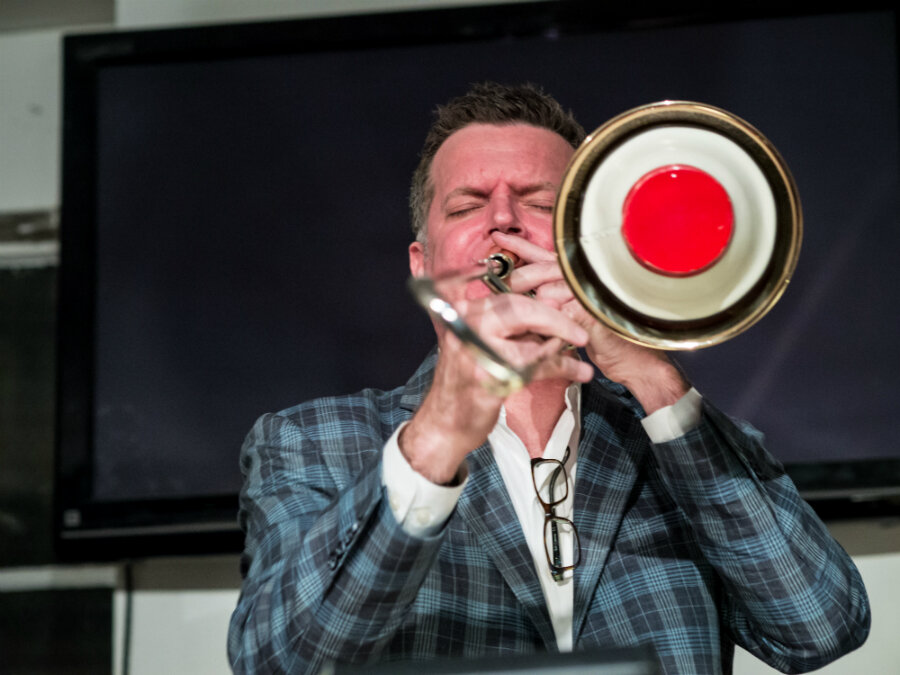Trombone Talk: Joe Fiedler Speaks
 Trombonist Joe Fiedler is a Jazz Gallery mainstay. But every time he’s come onstage over his long and impressive career, he’s brought a drastically different act from the last one. Last year, it was with Big Sackbut, his freewheeling brass quartet. This time, it will be with his trombone trio, a highly unusual setup, but one that Fielder cherishes. We caught up with Mr. Fiedler by phone to talk about the joys and challenges of playing in this exposed setting.The Jazz Gallery: You’re known for pushing form and experimenting with different instrumentation. Is the trio setup constraining in comparison?
Trombonist Joe Fiedler is a Jazz Gallery mainstay. But every time he’s come onstage over his long and impressive career, he’s brought a drastically different act from the last one. Last year, it was with Big Sackbut, his freewheeling brass quartet. This time, it will be with his trombone trio, a highly unusual setup, but one that Fielder cherishes. We caught up with Mr. Fiedler by phone to talk about the joys and challenges of playing in this exposed setting.The Jazz Gallery: You’re known for pushing form and experimenting with different instrumentation. Is the trio setup constraining in comparison?
Joe Fiedler: No. The trio has been my favorite project I’ve ever had. It’s been together 12, 14 years. That form is my first love. And it’s easier to go into that mode—Big Sackbut mode is a whole different ball of wax.
TJG: Your current iteration of your trio has Rob Jost on bass instead of longtime collaborator John Hebert. What’s different about this lineup?
JF:When I first started “Sesame Street” [Fiedler is a musical director and band member at the beloved PBS show] I was finishing up a new trio record, “Sacred Chrome Orb” [in 2011]. John was still in the band, but he was so, so busy becoming a jazz bass superstar, working with Fred Hersch, Paul Motian, all these guys.I was working with Rob on “Sesame Street,” and thought he would be a great fit. I think a lot of groups succeed by having very strong personalities that all do their thing at the same time. There’s a level of a confidence in their own vocabulary they have: ‘I’m gonna impose my thing, no matter what.’ And John Hebert fits that mold. He’s such a complete player and a mature voice.Rob doesn’t come from playing in that more open setting. It’s more about, ‘how can I fit in and be more supportive?’ So there’s much more of a group dynamic with Rob than with John. And that’s no knock on John—he’s one of my favorite musicians ever. But as a unit, we’ve been able to take some of the compositions and really mine them for nuance.
TJG: What are some of the trombone techniques you explore on this album?
JF: The main thing is using the plunger technique. It’s just a basic toilet plunger that’s been used since Duke Ellington’s big band. But maybe unlike a lot of classic trombone guys, like Al Grey or Quentin “Butter” Jackson, I like to use it as a textural element, similarly to Ray Anderson.Since we only have three instruments, how can we get different timbres and colors without it being stagnant?Usually, I like to mix and match the mutes I use. But I wanted to get as many shadings out of one mute as possible. So half the record is using plunger, and for those five tunes, there’s such a different sonic component each time. Sometimes I’m growling, sometimes I’m using multiphonics: singing through the trombone while playing another note.
TJG:Why do we hardly see any trombone trios these days?
JF: The primary reason, in my estimation, is the physicality of it. Playing a brass instrument in general, having a piece of metal pressed into your lip, requires a lot of endurance. You’re cutting off the circulation of blood in your face! Miles Davis, for instance—on the classic records, he takes his nice solo, and then the piano will take a solo, and he gets to hang out. But with a trio there’s very little downtime.
TJG: How have you been able to manage that physicality?
JF: I’ve always, I’d like to think, been a guy with really strong chops. I’ve built up a certain level of endurance, in Latin jazz groups like with Eddie Palmieri, playing loudly and with lots of high notes. And growing up with the records I did, having that sound of the trio in my head—it made me wonder, can I make this happen?It’s not for the faint of heart, I won’t lie. You play one set, and your chops are kind of busted. So it’s about learning how to pace your set better. But I like the challenge of it.
TJG: You’re known as a stylistic chameleon. Is there a sonic home base that you find yourself coming back to?
JF: The trio is my home base. It allows me to get the most out of my creative vision. I like to use a lot of extended techniques and extreme ranges and my multiphonics that I’ve been developing my whole career. And especially if you’re playing with a chordal instrument, it definitely can force your playing into a certain way. I feel I’m at my best when I’m able to explore all the sonic possibilities I have in my imagination.
The Joe Fiedler Trio celebrates the release of their new album I'm In (Multiphonics Music) at The Jazz Gallery on Friday, April 10th, 2015. The group features Mr. Fiedler on trombone, Rob Jost on bass, and Michael Sarin on drums. Sets are at 8 and 10 p.m. $15 general admission ($10 for members) for the first set, $10 general admission ($8 for members) for the second. Purchase Tickets Here.
